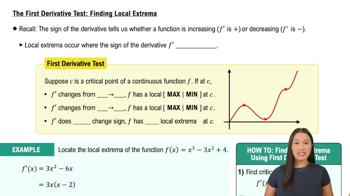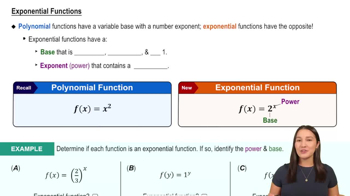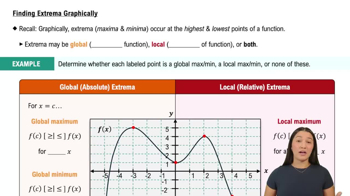Table of contents
- 0. Functions7h 52m
- Introduction to Functions16m
- Piecewise Functions10m
- Properties of Functions9m
- Common Functions1h 8m
- Transformations5m
- Combining Functions27m
- Exponent rules32m
- Exponential Functions28m
- Logarithmic Functions24m
- Properties of Logarithms34m
- Exponential & Logarithmic Equations35m
- Introduction to Trigonometric Functions38m
- Graphs of Trigonometric Functions44m
- Trigonometric Identities47m
- Inverse Trigonometric Functions48m
- 1. Limits and Continuity2h 2m
- 2. Intro to Derivatives1h 33m
- 3. Techniques of Differentiation3h 18m
- 4. Applications of Derivatives2h 38m
- 5. Graphical Applications of Derivatives6h 2m
- 6. Derivatives of Inverse, Exponential, & Logarithmic Functions2h 37m
- 7. Antiderivatives & Indefinite Integrals1h 26m
- 8. Definite Integrals4h 44m
- 9. Graphical Applications of Integrals2h 27m
- 10. Physics Applications of Integrals 2h 22m
5. Graphical Applications of Derivatives
Intro to Extrema
Problem 4.3.43
Textbook Question
Increasing and decreasing functions. Find the intervals on which f is increasing and the intervals on which it is decreasing.
f(x) = xe⁻(ˣ²/₂)
 Verified step by step guidance
Verified step by step guidance1
To determine where the function f(x) = x * e^(-x²/2) is increasing or decreasing, we first need to find its derivative, f'(x). Use the product rule for differentiation, which states that if you have a function h(x) = u(x) * v(x), then h'(x) = u'(x) * v(x) + u(x) * v'(x). Here, u(x) = x and v(x) = e^(-x²/2).
Differentiate u(x) = x to get u'(x) = 1. For v(x) = e^(-x²/2), use the chain rule. The derivative of e^u is e^u * u', where u = -x²/2. So, v'(x) = e^(-x²/2) * (-x).
Apply the product rule: f'(x) = u'(x) * v(x) + u(x) * v'(x) = 1 * e^(-x²/2) + x * (-x) * e^(-x²/2). Simplify this to get f'(x) = e^(-x²/2) - x² * e^(-x²/2).
Factor out e^(-x²/2) from f'(x): f'(x) = e^(-x²/2) * (1 - x²). The sign of f'(x) depends on the sign of (1 - x²) since e^(-x²/2) is always positive.
Solve the inequality 1 - x² > 0 to find where f'(x) > 0 (increasing) and 1 - x² < 0 for f'(x) < 0 (decreasing). The solution to 1 - x² > 0 is -1 < x < 1, so f(x) is increasing on (-1, 1). For 1 - x² < 0, x < -1 or x > 1, so f(x) is decreasing on (-∞, -1) and (1, ∞).
 Verified video answer for a similar problem:
Verified video answer for a similar problem:This video solution was recommended by our tutors as helpful for the problem above
Video duration:
7mPlay a video:
Was this helpful?
Key Concepts
Here are the essential concepts you must grasp in order to answer the question correctly.
Critical Points
Critical points are values of x in a function where the derivative is either zero or undefined. These points are essential for determining where a function changes from increasing to decreasing or vice versa. To find critical points, we first compute the derivative of the function and set it equal to zero, solving for x.
Recommended video:

Critical Points
First Derivative Test
The First Derivative Test is a method used to determine the behavior of a function at its critical points. By analyzing the sign of the derivative before and after each critical point, we can conclude whether the function is increasing or decreasing in those intervals. If the derivative changes from positive to negative, the function is decreasing; if it changes from negative to positive, the function is increasing.
Recommended video:

The First Derivative Test: Finding Local Extrema
Exponential Functions
Exponential functions, such as f(x) = xe⁻(ˣ²/₂), involve a constant raised to a variable exponent. In this case, the function combines polynomial and exponential components, which can affect its growth and decay rates. Understanding the behavior of exponential functions is crucial for analyzing their derivatives and determining intervals of increase and decrease.
Recommended video:

Exponential Functions

 5:58m
5:58mWatch next
Master Finding Extrema Graphically with a bite sized video explanation from Callie
Start learning





